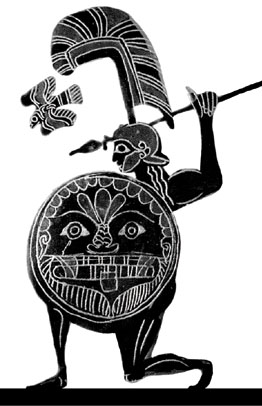 |
 >
Roman Life >
Roman Life
Interior Decoration
Until last century of Republic => houses small, simple, little decoration.
Interiors had bright colors.
At first, stuccoed walls marked off into rectangular panels => colored w/ reds, yellows
Later, at center panel of each wall, painted picture w/ frame.
Large pictures (figures, interiors, landscapes) => frescoed all over walls.
Walls decorated with marble slabs, baseboards, cornices.
Slabs of different color marbles combined => Romans look for strikingly colored marble.
Raised figures then used, modeled in stucco with gold leaf, colors and mosaic work
Mosaic had pieces of colored glass to give jeweled effect.
Ceilings vaulted, painted w/ brilliant colors, divided into panels by heavy wood or marble beams.
Beams often carved Panels decorated w/ stucco work, gold or glided bronze plates.
Imitated by modern architects.
Doors richly paneled + carved. Plated with bronze or made of bronze.
Doorposts sheathed w/ carved marble.
Floors covered w/ marble tiles => contrasting colors, geometrical figures or pictures
¡°Battle of Issus¡± => 6 x 8 feet with 100 pieces in each sq. inch.
Furniture – of stone or metal. Restored from casts made at Pompeii and Herculaneum by pouring plaster into shells in the volcanic mud.
Cared little for comfort, but artistic form important, expensive materials, fine workmanship.
Bronze or marble statues decorate atrium, peristyle or garden.
Made reproductions of famous sculptures found in ancient cities.
No mirrors, desks or writing tables, chests of drawers, cabinets w/ glass doors.
Essential articles: Couches, chairs, tables and lamps.
Others: Chests, wooden cabinets w/ doors, brazier for hot coals, water clock.
Lectus – couch – sofa during day, bed at night.
Wooden frame w/ straps across top
The back for the lectus was a Roman addition.
Always provided w/ mattress, pillows and coverlets.
Mattresses => stuffed w/ straw => wool => (sometimes) feathers.
In Pompeii, no couches found, mattress might be laid on built in support.
If large couches, stoops/stepladders provided.
Used as sofa in library, in dining room as dining couch, in atrium -> wedding couch
Beautiful wood used for legs/arms, carved/inlaid with tortoise shell, ivory, prec. metals.
Covered in fine fabrics, dyed in colors, embroidered w/ gold.
Seat for Romans - Stool/Bench with 4 legs and no back. Some could be folded. For one person.
Curule chair => high magistrates only – folding stool w/ curved legs of ivory, purple cushion.
Benches used in houses, by jurors, boys in school, senators in curia.
Footstools => keep feet from cold floor.
Solium – stiff, straight, high-backed chair, with solid arms. Foot stool necessary.
Cut from single block of wood. Patron sat when receive clients, poets: seat for gods/kings
Cathedra – armless chair with curved back, cathedra supina – back fixed at easy angle
Most comfortable. Used only for women => men used it too.
Ex Cathedrae – teachers in rhetoric school sit in it, meaning authoritative utterance
Explains cathedral (bishops use this expression)
Cushions used, but chair not upholstered. Skillful workmanship, elaborate decoration.
Tables – supports/tops of stone, wood (solid/veneered), covered w/ thin sheets of precious metals
Most expensive => cross sections of citrus wood, African cedar (3-4 feet diameter sawed out)
Cicero => $40,000, could be up to $120,000.
Monopodium – table/stand with one support, hold lamp
Abacus – rectangular table with raised rim, sideboard to hold dishes
Mensa delphica – 3 legs
Tables - adjustable legs, raised/lowered | Masonry/concrete table built into peristyle/dining room
Chests => clothes, safekeep papers, money, jewelry. Made of wood, bound w/ iron.
Ornamental hinges, locks of bronze. Small ones (jewel cases) made of silver/god.
Strongbox in tablinum => head of family kept money. Made of metal/wood reinforced w/ metal.
Very heavy, chained to floor, richly ornamented.
Cabinets same material as chests, decorated, div¡¯d into compartments, no sliding drawers.
Wooden doors had no hinges/locks.
In library kept books, in alae held wax masks of ancestors.
Charcoal stoves – braziers => metal boxes held hot coals. Raised legs (don¡¯t damage floor)
Handles -> carried from room to room. Decorated.
Sundials => in peristyle – measured hours w/ shadow of stick/pin. Intro¡¯d from Greece (268 BC)
Give correct time twice a year if calculated for spot it stands.
Since first ones from Greece, not give correct times.
Largest at Rome => Augustus made w/ Egyptian obelisk and lines on marble pavement.
Clepsydra – water clock – Greeks – marked hours night/day, used indoors.
Container of water, escape at fixed rate, level marking hours.
Not accurate, Roman hours varied in length w/ season of year.
Lamps – container for olive oil/melted fat, w/ twisted thread for wick(s) through 1+ holes at top.
Hole to fill lamp as well. No chimney to keep flame steady, unsteady light.
Beautifully made
Handles to carry around | Suspend from ceiling | Adjustable stands (monopodia, tripods)
Candelabrum – tall stands hang several lamps. For public rooms – originally for candles
But Romans no good at candlemaking.
Faces – torches – dry inflammable wood – soaked/smeared in pitch – kept near door
|

